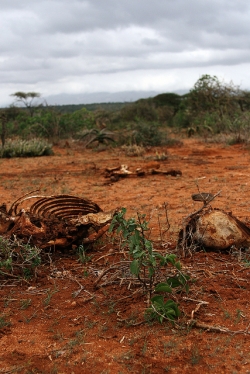 Jonathan Clayton, The Times Africa correspondent, criticised aid agencies for overstating the effects of the east Africa crisis when he wrote: “This month we have been told that East Africa, including Kenya and Uganda, where virtually anything grows and banana trees line the roads, is suffering the worst drought in 60 years…”
Jonathan Clayton, The Times Africa correspondent, criticised aid agencies for overstating the effects of the east Africa crisis when he wrote: “This month we have been told that East Africa, including Kenya and Uganda, where virtually anything grows and banana trees line the roads, is suffering the worst drought in 60 years…”
We left Addis on a wet Sunday morning on the first leg of our journey to Borana in southern Ethiopia. As we leave Addis, we drive past kilometres of flower farms, fields of sprouting beans, two metre high corn plants and other lush crops growing in the rich black soils of the Rift Valley.
The rain continues to fall as we continue to head south and after four hours of driving we have seen nothing but freshly ploughed fields, and lush plantations of beans, false banana, deep green corn plants and women sitting on the side of the road roasting huge corn cobs.
After a while you can’t help but ask yourself if maybe Jonathan is right, where is the drought everyone is crying about?
And then as you leave the Rift valley to enter Borana, the contrast couldn’t be starker.
Endless search for pasture and water
The landscape changes dramatically. The rich black soils of the Rift Valley have given way to the dry red soil of the Sahel. The scenery has suddenly switched from moist, lush, green growth to dry, red, dusty soils.
Visions of lush, green growth are replaced by the pathetic sight of the mass migration of thin cattle, donkeys, goats, sheep and camel endlessly searching for pasture and water.
The lush green banana trees have been replaced with thorn trees and looking up you see vultures circling instead of rain falling.
The contrast could not be more dramatic and Jonathan couldn’t have been more wrong about this crisis in East Africa. He accused aid agencies like Oxfam and Christian Aid of hyping up a “localised drought” and for crying wolf.
“What happens when there is a real emergency? Will we believe them?”
“Yes! Jonathan we will believe them”
East Africa crisis is real and demands the world’s attention
The generous British public believed. It chose to ignore sceptics like Jonathan Clayton and listen to the aid agencies that were not crying wolf but instead demanding the world’s attention to a looming disaster in the Horn of Africa.
Aid agencies analyse the evidence, avoid generalising and they don’t stereotype countries. Bananas don’t line all the roads in Kenya, and it’s not the case that “anything” grows in Kenya, Uganda and Ethiopia.
“Who will believe them?” The British public believed, Jonathan. Over thirty million times the British public believed the aid agencies and shared generously.
Ten million people are in danger
However, the unfortunate reality remains that their belief, though a major step, is not enough.
I have seen the carcasses that line the cattle migration routes, the vultures circling in the sky. I have seen the depressing migration of thin animals and concerned pastoralists who follow their animals and their livelihoods in a desperate attempt to survive.
With over ten million lives in danger, they need a lot more than public belief. And they need it now.
Read more about the drought in Ethiopia
HelpAge’s work is supported by our sister organisation Age UK. Please donate to Age UK’s East Africa appeal for vulnerable older people affected by the devastating drought in Ethiopia.
Age UK is raising money together with the Disasters Emergency Committee (DEC) for the East Africa Crisis Appeal. The DEC is a consortium of 14 aid agencies working together in times of disasters and emergencies.
